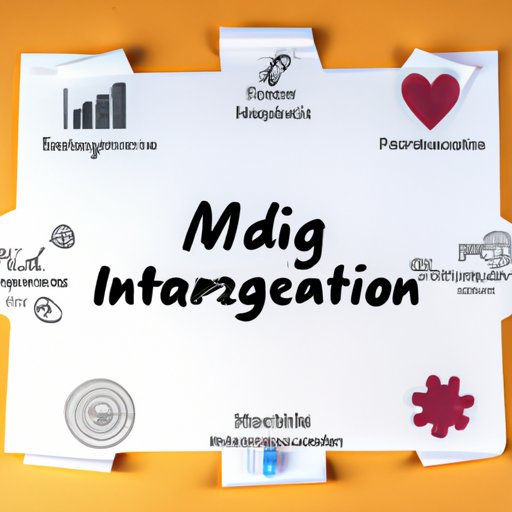
Introduction
Integrated marketing communications, or IMC, has become increasingly important in today’s fast-paced digital era. With so many communication channels available, it’s easy to get overwhelmed and confused about how to effectively market your product or service. This article aims to provide you with a comprehensive guide to understanding IMC and how to implement it successfully in your marketing strategy.
Understanding IMC: The Importance of Integrated Marketing Communications
Integrated marketing communications, simply put, is the coordination and integration of all marketing communication tools, avenues, and sources within a company into a seamless program that maximizes the impact on customers and other stakeholders. IMC is essential for businesses that want to create a more consistent, resonant message, and powerful brand presence across multiple channels.
IMC offers several benefits to companies, including:
- Increased brand recognition and loyalty
- Improved customer engagement and acquisition
- Better Return on Investment (ROI)
- Enhanced marketing efficiency and effectiveness
Compared to traditional marketing and advertising, IMC involves greater collaboration and alignment between multiple departments, including marketing, sales, and customer service.
IMC 101: A Beginner’s Guide to Integrated Marketing Communications
Developing an IMC plan starts with understanding your target audience and the various communication channels available to reach them. Your target audience consists of the people most likely to purchase your product or service, and knowing their demographics and interests is key to selecting the optimal channels for your message.
The process of developing an IMC plan involves:
- Setting clear objectives and identifying tactics to achieve them
- Determining your target audience and choosing relevant channels to reach them
- Developing your message and tone of voice
- Creating a visual identity for your brand across all channels
- Determining how you will measure the success of your IMC plan
Why IMC is Crucial to Your Marketing Strategy and How to Implement It
IMC is an essential part of any marketing strategy, as it ensures that all communication channels resonate with the same message and tone of voice. IMC implementation requires a comprehensive plan that includes strategies for each channel of communication. Depending on your goals, you may focus more on digital marketing or traditional methods like personal selling or advertising. It’s important to identify the right mix for your business.
Common misconceptions about IMC include that it is too costly or that it only benefits larger, established companies. However, businesses of all sizes can benefit from IMC if implemented properly.
Breaking Down IMC: The Six Key Components of Integrated Marketing Communications
There are six key components of IMC that companies use to engage with their customers:
- Advertising: Paid communication promoting your product or service through various media platforms, such as television, radio, newspapers, or billboards. Online advertising usually involves PPC (pay-per-click) ads.
- Direct Marketing: Direct communication with customers, often through mail or email, offering promotions, discounts, or other benefits.
- Sales Promotions: Special discounts or other incentives offered to customers to encourage purchase.
- Personal Selling: Direct communication between a salesperson and potential customers.
- Public Relations: Free media coverage of your company or product through press releases, media pitches, and other publicity tactics.
- Digital Marketing: Marketing efforts aimed at reaching customers through online channels such as social media, websites, and mobile apps.
Case Study: How IMC Helped Leading Brands Drive Business Success
Several leading brands have successfully leveraged IMC to drive business growth. For example, Dove’s “Campaign for Real Beauty” utilized advertising, public relations, and direct marketing to promote a more realistic “beauty standard,” while also receiving millions of impressions and social media engagements. Another example is the Old Spice marketing campaign, which deployed engaging advertising and a popular social media campaign to revitalize and reposition the brand. Coca-Cola’s “Share a Coke” campaign used personal selling, social media, and advertising to increase brand engagement and drive sales.
These case studies illustrate the effectiveness of IMC when it comes to brand recognition, customer engagement, and increased sales.
IMC in a Digital Age: Navigating the Changing Landscape of Marketing Communications
The rise of digital marketing has brought new opportunities and challenges to IMC. With the proliferation of numerous social media platforms, each with its unique user base and communication style, businesses must navigate through this digital landscape with a cohesive, omnichannel strategy.
Strategies for successfully incorporating digital marketing into an IMC plan include identifying the unique audience segments on each platform, tailoring messaging to fit the distinctive culture of each, and using data to continuously optimize ad targeting and personalization. Of course, challenges also exist in the form of algorithm changes, privacy concerns, and managing current and potential customers on multiple channels.
Conclusion
The importance of IMC cannot be understated in today’s marketing landscape. By coordinating all communication channels to a cohesive message and brand identity, businesses can improve customer engagement, loyalty, and recognition, ultimately driving sales and growth. Remember to start by understanding your target audience and identifying the most effective channels to reach them. When implemented properly, IMC can take your marketing to the next level.




